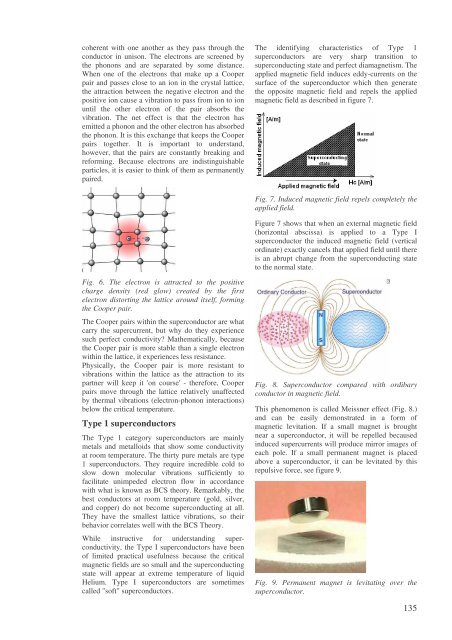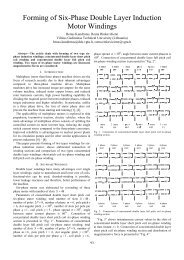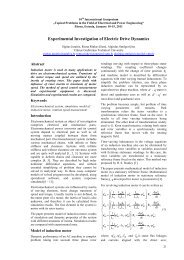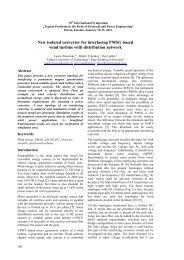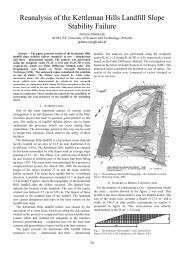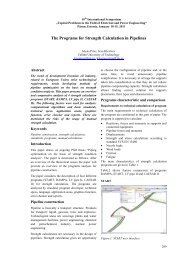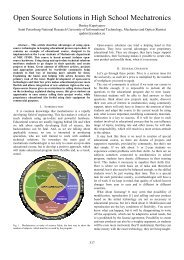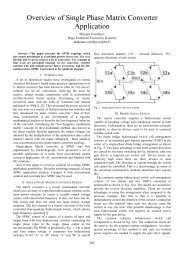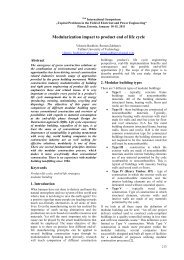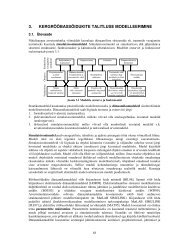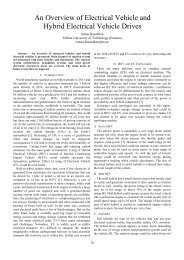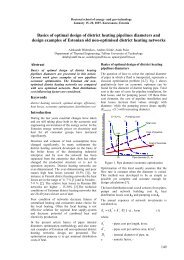The essence of superconductivity and superconductors.
The essence of superconductivity and superconductors.
The essence of superconductivity and superconductors.
You also want an ePaper? Increase the reach of your titles
YUMPU automatically turns print PDFs into web optimized ePapers that Google loves.
coherent with one another as they pass through theconductor in unison. <strong>The</strong> electrons are screened bythe phonons <strong>and</strong> are separated by some distance.When one <strong>of</strong> the electrons that make up a Cooperpair <strong>and</strong> passes close to an ion in the crystal lattice,the attraction between the negative electron <strong>and</strong> thepositive ion cause a vibration to pass from ion to ionuntil the other electron <strong>of</strong> the pair absorbs thevibration. <strong>The</strong> net effect is that the electron hasemitted a phonon <strong>and</strong> the other electron has absorbedthe phonon. It is this exchange that keeps the Cooperpairs together. It is important to underst<strong>and</strong>,however, that the pairs are constantly breaking <strong>and</strong>reforming. Because electrons are indistinguishableparticles, it is easier to think <strong>of</strong> them as permanentlypaired.<strong>The</strong> identifying characteristics <strong>of</strong> Type 1<strong>superconductors</strong> are very sharp transition tosuperconducting state <strong>and</strong> perfect diamagnetism. <strong>The</strong>applied magnetic field induces eddy-currents on thesurface <strong>of</strong> the superconductor which then generatethe opposite magnetic field <strong>and</strong> repels the appliedmagnetic field as described in figure 7.Fig. 7. Induced magnetic field repels completely theapplied field.Figure 7 shows that when an external magnetic field(horizontal abscissa) is applied to a Type Isuperconductor the induced magnetic field (verticalordinate) exactly cancels that applied field until thereis an abrupt change from the superconducting stateto the normal state.Fig. 6. <strong>The</strong> electron is attracted to the positivecharge density (red glow) created by the firstelectron distorting the lattice around itself, formingthe Cooper pair.<strong>The</strong> Cooper pairs within the superconductor are whatcarry the supercurrent, but why do they experiencesuch perfect conductivity? Mathematically, becausethe Cooper pair is more stable than a single electronwithin the lattice, it experiences less resistance.Physically, the Cooper pair is more resistant tovibrations within the lattice as the attraction to itspartner will keep it 'on course'- therefore, Cooperpairs move through the lattice relatively unaffectedby thermal vibrations (electron-phonon interactions)below the critical temperature.Type 1 <strong>superconductors</strong><strong>The</strong> Type 1 category <strong>superconductors</strong> are mainlymetals <strong>and</strong> metalloids that show some conductivityat room temperature. <strong>The</strong> thirty pure metals are type1 <strong>superconductors</strong>. <strong>The</strong>y require incredible cold toslow down molecular vibrations sufficiently t<strong>of</strong>acilitate unimpeded electron flow in accordancewith what is known as BCS theory. Remarkably, thebest conductors at room temperature (gold, silver,<strong>and</strong> copper) do not become superconducting at all.<strong>The</strong>y have the smallest lattice vibrations, so theirbehavior correlates well with the BCS <strong>The</strong>ory.While instructive for underst<strong>and</strong>ing <strong>superconductivity</strong>,the Type I <strong>superconductors</strong> have been<strong>of</strong> limited practical usefulness because the criticalmagnetic fields are so small <strong>and</strong> the superconductingstate will appear at extreme temperature <strong>of</strong> liquidHelium. Type I <strong>superconductors</strong> are sometimescalled "s<strong>of</strong>t" <strong>superconductors</strong>.Fig. 8. Superconductor compared with ordibaryconductor in magnetic field.This phenomenon is called Meissner effect (Fig. 8.)<strong>and</strong> can be easily demonstrated in a form <strong>of</strong>magnetic levitation. If a small magnet is broughtnear a superconductor, it will be repelled becausedinduced supercurrents will produce mirror images <strong>of</strong>each pole. If a small permanent magnet is placedabove a superconductor, it can be levitated by thisrepulsive force, see figure 9.Fig. 9. Permanent magnet is levitating over thesuperconductor.135


